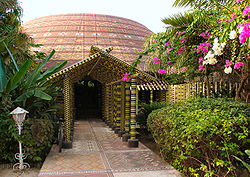
Impluvium
Encyclopedia

Atrium (architecture)
In modern architecture, an atrium is a large open space, often several stories high and having a glazed roof and/or large windows, often situated within a larger multistory building and often located immediately beyond the main entrance doors...
in a Greek or Roman house (domus
Domus
In ancient Rome, the domus was the type of house occupied by the upper classes and some wealthy freedmen during the Republican and Imperial eras. They could be found in almost all the major cities throughout the Roman territories...
). Designed to carry away the rainwater coming through the compluvium of the roof, it is usually made of marble
Marble
Marble is a metamorphic rock composed of recrystallized carbonate minerals, most commonly calcite or dolomite.Geologists use the term "marble" to refer to metamorphosed limestone; however stonemasons use the term more broadly to encompass unmetamorphosed limestone.Marble is commonly used for...
and placed about 30 cm below the floor of the atrium.
The name is also used for a type of dwelling typical of the Jola
Jola people
The Jola are an ethnic group found in Senegal , The Gambia, and Guinea-Bissau. There are great numbers on the Atlantic coast between the southern banks of the Gambia River, the Casamance region of Senegal and the northern part of Guinea-Bissau...
in the Casamance
Casamance
Casamance is the area of Senegal south of The Gambia including the Casamance River. It consists of Basse Casamance and Haute Casamance...
region of Senegal
Senegal
Senegal , officially the Republic of Senegal , is a country in western Africa. It owes its name to the Sénégal River that borders it to the east and north...
. It is a circular mud building, built with a ring of rooms around a walkway that circumscribes a central water trench, fed by an opening that allows water into the building. Impluvia remain cool in very hot weather as the water evaporates. There is a particularly fine example that serves as a hotel in Enampore
Enampore
Enampore is a village in the Casamance region of Senegal. It lies about 23 kilometres from the Casamance's chief town Ziguinchor. It is noted for its impluvium houses, which are a distinctive feature of Jola architecture....
. Impluvial architecture is also used by the Igbo
Igbo people
Igbo people, also referred to as the Ibo, Ebo, Eboans or Heebo are an ethnic group living chiefly in southeastern Nigeria. They speak Igbo, which includes various Igboid languages and dialects; today, a majority of them speak English alongside Igbo as a result of British colonialism...
, Yoruba
Yoruba people
The Yoruba people are one of the largest ethnic groups in West Africa. The majority of the Yoruba speak the Yoruba language...
and Edo
Edo
, also romanized as Yedo or Yeddo, is the former name of the Japanese capital Tokyo, and was the seat of power for the Tokugawa shogunate which ruled Japan from 1603 to 1868...
of southern Nigeria, in which they consist of small courtyards cornered with large pots to collect rain water. Edo and Yoruba houses usually consist of several impluvia and courts. The amount and size of these courts depend on the social and economic status of the individual. Royal palaces in Yorubaland and the Kingdom of Benin possessed hundreds of impluvia sometimes floored with elaborate pavements made of potsherds and quartz pebbles arranged in decorative patterns.
Inspection (without excavation) of impluvia in Paestum, Pompei and Rome by an American Civil Engineer indicated that the pavement surface in the impluvia were porous or the non-porous stone tiles were separated by a gap significant enough to allow a substantial quantity of water to stand in the basin of the impluvium, filter through the cracks and through layers of gravel and sand into a holding chamber below ground. The circular stone opening (visible in the photograph resembling a chimney pot) allows easy access by bucket and rope to this private, filtered and naturally cooled water supply. Similar water supplies were found elsewhere in the public spaces of the city with the stone cap showing the wear patterns of much use (the rope wear patterns also are visible in the photograph). In wet seasons, excess water that could not pass through the filter would overflow the basin and exit the building and any sediment or debris remaining in the surface basin could be swept away. In hot weather, water can be drawn from the cistern chamber (or fetched by slaves from supplies outside the domus) and cast into the shallow pool to evaporate and provide a cooling effect to the entire atrium. As the water evaporates, the surrounding air is cooled and becomes heavier and flows into the living spaces and is replaced by air drawn through the compluvium. The combination of the compluvium and impluvium formed an ingenious, effective and attractive manner of collecting, filtering and cooling rainwater and making it available for household use as well as providing cooling of the living spaces.
See also
- Roman architectureRoman architectureAncient Roman architecture adopted certain aspects of Ancient Greek architecture, creating a new architectural style. The Romans were indebted to their Etruscan neighbors and forefathers who supplied them with a wealth of knowledge essential for future architectural solutions, such as hydraulics...
- Architecture of Ancient GreeceArchitecture of Ancient GreeceThe architecture of Ancient Greece is the architecture produced by the Greek-speaking people whose culture flourished on the Greek mainland and Peloponnesus, the Aegean Islands, and in colonies in Asia Minor and Italy for a period from about 900 BC until the 1st century AD, with the earliest...

